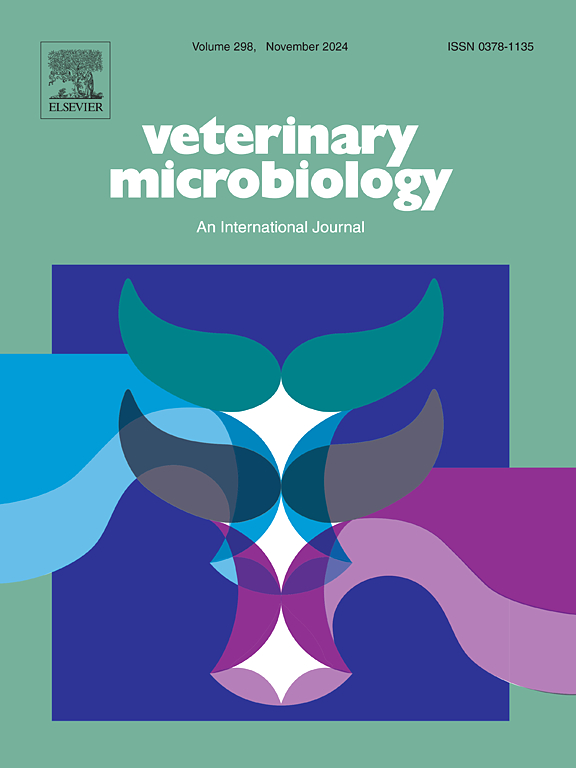OncomiR mdv1-miR-M7-5p通过调节BCL2/Bax线粒体凋亡信号通路促进禽类淋巴瘤。
IF 2.4
2区 农林科学
Q3 MICROBIOLOGY
引用次数: 0
摘要
马立克氏病病毒(MDV)是一种致癌的甲疱疹病毒,感染家禽并在感染的鸡中引起致命的淋巴瘤。值得注意的是,mdv1-miR-M7-5p是一种由MDV编码的关键oncomiR,与病毒复制和潜伏期密切相关。我们将mdv1-miR-M7-5p转染到鸡淋巴瘤细胞系MSB1中,抑制淋巴瘤细胞凋亡,增加淋巴瘤细胞的增殖和迁移。此外,肿瘤抑制基因p53和ARRDC3的表达显著下调,而MDV潜伏期相关基因ICP4和ICP27的表达显著上调。BCL2/Bax比值升高,凋亡信号通路相关基因表达降低。此外,我们在MSB1细胞中的线粒体功能实验表明,mdv1-miR-M7-5p增强线粒体ATP释放,改变线粒体膜电位,从而影响线粒体功能,抑制淋巴瘤细胞凋亡。双荧光素酶检测显示mdv1-miR-M7-5p与caspase-6结合。在体内研究中,给鸡注射了一种胆固醇修饰的mdv1-miR-M7-5p抑制剂。抑制mdv1-miR-M7-5p导致死亡率低于对照组。此外,mdv感染鸡血浆中细胞因子干扰素-γ (IFN-γ)、白细胞介素-4 (IL)-4和IL-17的表达水平显著升高。脾脏组织细胞凋亡明显增加,脾脏、法氏囊、胸腺等免疫器官细胞凋亡相关基因caspase-3、肿瘤抑制基因PTEN表达明显上调。综上所述,致癌miRNA mdv1-miR-M7-5p可促进MDV潜伏期,并可能通过介导BCL2/CytC信号通路促进淋巴瘤形成。这种介质增强线粒体功能,抑制淋巴瘤细胞凋亡,从而促进淋巴瘤的发展。本文章由计算机程序翻译,如有差异,请以英文原文为准。
OncomiR mdv1-miR-M7-5p promotes avian lymphomatosis by modulating the BCL2/Bax mitochondrial apoptosis signaling pathway
Marek's disease virus (MDV) is an oncogenic alphaherpesvirus that infects poultry and causes fatal lymphomas in infected chickens. Notably, the mdv1-miR-M7–5p, a pivotal oncomiR encoded by MDV, is closely associated with viral replication and latency. Here, mdv1-miR-M7–5p was transfected into the chicken lymphoma cell line MSB1, which resulted in the inhibition of lymphoma cell apoptosis and an increase in lymphoma cell proliferation and migration. Additionally, the expression of the tumor suppressor genes p53 and ARRDC3 were significantly downregulated, while the MDV latency-associated genes such as ICP4 and ICP27 were significantly upregulated. The BCL2/Bax ratio was increased while the expression of genes involved in the apoptotic signaling pathway were decreased. Furthermore, our mitochondrial function experiments in MSB1 cells demonstrated that mdv1-miR-M7–5p enhanced mitochondrial ATP release and altered the mitochondrial membrane potential, thereby affecting mitochondrial function and inhibiting lymphoma cell apoptosis. Dual-luciferase assays revealed that mdv1-miR-M7–5p binds to caspase-6. For the in vivo study, a cholesterol-modified inhibitor of mdv1-miR-M7–5p was administered to chickens. Inhibition of mdv1-miR-M7–5p resulted in a lower mortality rate than that in the control groups. Furthermore, the expression levels of the cytokines interferon-gamma (IFN-γ), interleukin (IL)-4, and IL-17 in the plasma of MDV-infected chickens were significantly increased. A marked increase was observed in apoptosis in the spleen tissues, and the expression of apoptosis-related genes including caspase-3 and tumor suppressor gene PTEN in immune organs, including the spleen, bursa of Fabricius, and thymus, were markedly upregulated. In summary, the oncogenic miRNA mdv1-miR-M7–5p promotes MDV latency and may facilitate lymphoma formation by mediating the BCL2/CytC signaling pathway. This mediation enhances mitochondrial function and inhibits lymphoma cell apoptosis, thereby contributing to lymphoma development.
求助全文
通过发布文献求助,成功后即可免费获取论文全文。
去求助
来源期刊

Veterinary microbiology
农林科学-兽医学
CiteScore
5.90
自引率
6.10%
发文量
221
审稿时长
52 days
期刊介绍:
Veterinary Microbiology is concerned with microbial (bacterial, fungal, viral) diseases of domesticated vertebrate animals (livestock, companion animals, fur-bearing animals, game, poultry, fish) that supply food, other useful products or companionship. In addition, Microbial diseases of wild animals living in captivity, or as members of the feral fauna will also be considered if the infections are of interest because of their interrelation with humans (zoonoses) and/or domestic animals. Studies of antimicrobial resistance are also included, provided that the results represent a substantial advance in knowledge. Authors are strongly encouraged to read - prior to submission - the Editorials (''Scope or cope'' and ''Scope or cope II'') published previously in the journal. The Editors reserve the right to suggest submission to another journal for those papers which they feel would be more appropriate for consideration by that journal.
Original research papers of high quality and novelty on aspects of control, host response, molecular biology, pathogenesis, prevention, and treatment of microbial diseases of animals are published. Papers dealing primarily with immunology, epidemiology, molecular biology and antiviral or microbial agents will only be considered if they demonstrate a clear impact on a disease. Papers focusing solely on diagnostic techniques (such as another PCR protocol or ELISA) will not be published - focus should be on a microorganism and not on a particular technique. Papers only reporting microbial sequences, transcriptomics data, or proteomics data will not be considered unless the results represent a substantial advance in knowledge.
Drug trial papers will be considered if they have general application or significance. Papers on the identification of microorganisms will also be considered, but detailed taxonomic studies do not fall within the scope of the journal. Case reports will not be published, unless they have general application or contain novel aspects. Papers of geographically limited interest, which repeat what had been established elsewhere will not be considered. The readership of the journal is global.
 求助内容:
求助内容: 应助结果提醒方式:
应助结果提醒方式:


